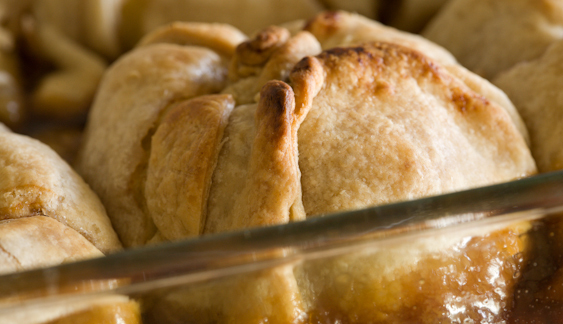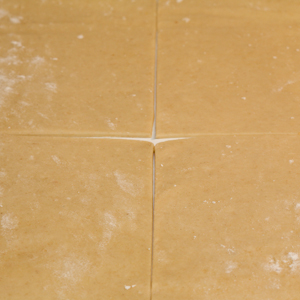Caramel Baked Apple Dumplings

introduction
Like a cupcake, a dumpling is round and generous, self-contained and messy, both more and less disciplined than a “slice” of anything. (In fact the word dumpling is so appealing it makes a “slice” sound almost mean.) But unlike a cupcake, a dumpling wraps itself around a secret, luscious filling—in this case a cinnamon sugar–dredged apple. Apple dumplings have been a chief part of my (Kay’s) Thanksgivings since childhood—Southern Germany by way of rural Indiana, with my Grandmother’s deft touch. They were always baked in brown sugar syrup and slumped in their bowls like great, dozing matrons. The apples were tart, the cinnamon woodsy, the pastry tender, the syrup sweet. Served warm, with a spoon, they were pretty much unassailable.
We have resurrected this dessert using Anson Mills Colonial Style Fine Cloth-Bolted Pastry Flour, a crisp-tender pastry with many layers, the ethereally scented McIntosh apple (autumn’s creamy baking apple), and a caramel syrup. And, truthfully? They are even better than we remembered.
Baking Notes
We like McIntosh apples for this recipe for a number of reasons: Macs sing with sweet and zing with tart. They perfume the whole kitchen and bake to a lush creaminess. If you’d prefer another baking apple—one that remains firmer throughout baking—by all means use it.
The 6-inch pastry squares we call for in this recipe are the perfect size for 4- to 5-ounce whole apples. Working with 7½- or 8-ounce apples? Fine. You’ll need four apples instead of eight. Core and peel the big guys and cut them in half. They work perfectly.
Rapping cold dough smartly with a French rolling pin to soften it and shape it before you begin rolling it is perfectly okay—in fact, we recommend it.
equipment mise en place
To make the caramel, you will need a clean, dry, heavy-bottomed medium saucepan; a wooden spoon; a fine-mesh sieve; and a medium bowl or 2-cup (or larger) glass measuring cup.
To roll out the pastry, you will need parchment paper; a rolling pin; a ruler; a pizza cutter or a small, sharp knife; and a plate for stacking the dough squares.
To prepare the apples, you will need a small mixing bowl; a large mixing bowl; a small, sharp knife; an apple corer; and a peeler.
To bake the dumplings, you will need a pizza stone, a shallow 3-quart baking dish (such as a 9 by 13-inch Pyrex baking dish), and a pastry brush.
-
for the caramel:
-
10.5ounces (1½ cups) sugar
-
½cup spring or filtered water, hot
-
-
-
1recipe Flaky Lard and Butter Pastry or Essential All-Butter Pastry 2.1, chilled
-
2tablespoons unsalted butter, melted, for greasing the baking dish
-
-
for the apples:
-
7ounces (1 cup) sugar
-
1½teaspoons ground cinnamon
-
6tablespoons juice from 2 or 3 large, juicy lemons
-
8small (4- to 5-ounce) or 4 large (7- to 8-ounce) McIntosh apples
-
-
Make the caramel: Pour the sugar into a clean, dry, heavy-bottomed medium saucepan. Set the pan over medium-high heat and allow the sugar to melt without stirring. When a band of colored sugar (caramel) appears bubbling along the edge of the saucepan (fig. 1.1), begin to stir the white, unmelted sugar on the top into the melted caramel base with a wooden spoon (fig. 1.2). Reduce the heat to medium-low and continue stirring from time to time to incorporate the unmelted sugar into the caramel. This might take as long as 20 minutes—don’t rush it. When the sugar has completely melted and colored, the syrup will have a glassy, deep amber sheen and show no granularity (fig. 1.3). Remove the saucepan from the stove and pour the hot water into the caramel. Stand back: it will bubble like mad (fig. 1.4). Stir with the wooden spoon to encourage the caramel to melt into the water. Return the saucepan to low heat to dissolve any caramel clinging to the bottom of the saucepan or to the wooden spoon, 4 to 5 minutes. Strain the caramel through a fine-mesh sieve into a medium bowl or a 2-cup (or larger) glass measuring cup. You will have about 1¼ cups. Cover and set aside at room temperature until ready to use.
-
Roll out the pastry: Cut eight 8-inch squares of parchment paper. Remove the dough from the refrigerator and whack it sharply with a rolling pin to flatten it slightly. Cut the dough in half and return one half to the refrigerator. Roll out the other half on a lightly floured work surface into a 12-inch square, taking care to roll evenly from the center to the edges of the dough. Use a ruler and a pizza cutter or a small, sharp knife to cut the dough into four squares (fig. 2.1). Don’t worry if the squares of dough are imperfectly shaped or thicker in some parts than others—you’ll be able to correct that later. Stack the squares on a plate with a parchment square under each one and put the plate in the refrigerator. Roll out and cut the other half of the dough in the same way, stack the dough squares with parchment liners on top of the first four (fig. 2.2), and refrigerate.
-
Adjust the oven racks to the lowest and upper-middle positions. Place a pizza stone on the lower rack and heat the oven to 425 degrees. Brush the bottom and sides of a shallow 3-quart baking dish (such as a 9 by 13-inch Pyrex dish) with the melted butter and set it in the refrigerator.
-
Prepare the apples: Combine the sugar and cinnamon in a small mixing bowl and mix well. Pour the lemon juice into a large bowl. Working one at a time, trim the bottom of the apples to make sure they sit level on the counter. Thrust the apple corer through the center of the apple and then draw it out, removing the core (fig. 4.1). Push the core from the center of the corer and discard it. Use the corer to remove any remaining core or seeds from the center of the apple. Peel the apple and toss it in the bowl with the lemon juice, turning to coat it with juice (fig. 4.2). If your apples are large, cut them in half before tossing them in the lemon juice.
-
Make the dumplings: The dough will now be cold and easier to work with. Transfer a dough square with its parchment liner from the plate to the work surface and reshape it directly on the parchment with the goal of achieving a neat 6-inch square: use the rolling pin to straighten edges or even the thickness, or a pizza cutter and ruler to trim straggly edges. When you are satisfied with the pastry square, roll an apple around in the cinnamon sugar, coating it well, then stand the apple in the center of the dough (fig. 5.1). (If you’re using apple halves, roll the half in sugar and place it flat side down on the pastry square.) Rinse and dry your fingers. Lift up two opposite corners of the dough so that the apple is wrapped snugly around its base and twist the corners into a point at the top. Do the same with the other two corners. Pinch and roll the side seams to seal. When the dough is closed on all sides around the apple, crimp the edges a bit with your fingers and curl the lower corners into little points (fig. 5.2). Place the dumpling in the prepared baking dish and go on to the next. Once all the dumplings are made, you may choose to decorate them with little leaves: Roll dough scraps into a sheet and chill briefly. Cut leaves from the sheet, etch them with a small knife, moisten the backsides, and arrange the leaves on the dumplings. Brush the dumplings with milk or cream.
-
Bake the dumplings: Place the baking dish in the oven on the pizza stone and bake until the dumplings are golden and fragrant, 25 to 30 minutes. Remove the baking dish from the oven and pour the caramel between the dumplings. Using oven mitts, tilt the baking dish to coat the bottom evenly. Set the baking dish on the upper rack and continue to bake until the caramel is bubbling and the dumplings are well browned, about 5 minutes more. Remove from the oven and let cool slightly. Serve the dumplings warm with whipped cream or vanilla ice cream.
-
-
1.1

-
1.2

-
1.3

-
1.4

-
-
-
2.1

-
2.2

-
-
-
4.1

-
4.2

-
-
-
5.1

-
5.2

-